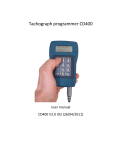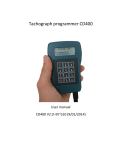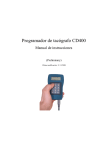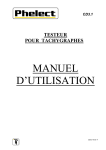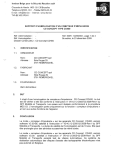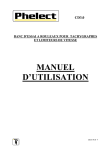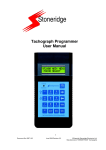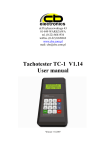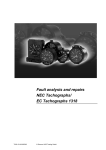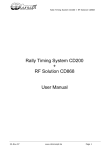Download Tachograph programmer CD400 User manual CD400 V2.0
Transcript
Tachograph programmer CD400 User manual CD400 V2.0 Last update : 04/12/2009 Tachograph programmer CD400 - User Manual (EN) Table of Contents 1. Introduction 1.1. What is a tachograph ? 2. Description 2.1. Technical specifications 2.2. Keyboard 2.3. Connections 3. Operation 3.1. Power supply and tachograph type detection 3.3. Functions available 3.3.1. Main menu 3.3.2. Measure W 3.3.2.1 Manual 3.3.2.1 Photo sensor 3.3.3. Measure K 3.3.4. Parameters 3.3.4.1. MTCO1324/1390 3.3.4.2. Motometer EGK100 3.3.4.3. Kienzle K1319 3.3.4.4. VR2400 3.3.4.5. DIGITAL TACHOGRAPHS (VDO/Actia/SE5000/EFAS) 3.3.5. Speed test 3.3.5.1 Manual 3.3.5.2 Automatic 3.3.6. Odometer test 3.3.7. Read DTCs 3.3.8. Erase DTCs 3.3.9. Sensor Pairing (Kitas activation) 3.3.10. Clock test 3.3.11. Select tachograph 3.3.12. Product info 3.3.13. Language 4. Software upgrade procedure Pdf version 1. Introduction 1.1. What is a tachograph ? Basically, a tachograph is a device that measures and records the speed and distance driven by a vehicle. The informations are recorded in the form of graphics on a paper disk. The new digital tachographs record those informations on its embedded memory and also on the smartcard of the driver. 2. Description 2.1. Technical specifications - Graphic FSTF LCD Display: (100 x 32 pix. / 4 lines x 20 char) White LED backlight - Size: 150 x 100 x 45 mm - Supply voltage: 9 to 30 VDC - Supply current: 12mA - Case: green-blue ABS (IP40) - Operating temp: -20…+70°C - Weight: 155g 2.2. Keyboard - Alternate function keys 'F1', 'F2' & 'F3' are active when a function in inverted video appears on the bottom line of the display. Track length 0020m MODIFY OK F1= MODIFY, F3=OK - Alernate function key '↑' & '↓' are used for example to navigate the menus. - Alernate function key '←' & '→' are used to select the digit in some parameters. - 'Ent' (=Enter) is used to select a function or enter a value. - 'Esc' key is used to go back in the menu, leave a function, to erase the last digit entered and to switch the programmer ON & OFF when powered by the battery. 2.3. Connections - Left connector: Serial port for software upgrade (upgrade cable). - Center connector: Connection for crocodile clip cable (K13xx/K1318). - Right connector: Connection for tachograph cable. 3. Operation 3.1. Power supply and tachograph type detection For all tachograph types, except for the K13xx/1318 and the FTCO1319, the programmer is powered by the tachograph itself. An automatic tachograph type detection is executed on power ON, so don't switch the programmer ON, simply connect it to the tachograph with the appropriate cable. The programmer will switch ON and detect the tachograph type. In the case of the K13xx/1318 and the FTCO1319, switch the programmer ON pressing the 'I/O' key. If the FTCO1319 is connected, the programmer will detect it. To switch the programmer OFF, press and hold the 'I/O' key. If no tachograph is detected, the K13xx/1318 will be selected by default. On power ON, the programmer will display the product information (Software version, Serial number, etc...), then the menu for the tachograph type detected. 3.3. Functions available 3.3.1. Main menu The functions available in the main menu depend on tachograph model detected (or selected manually). The tachograph model appears on the top line. KTCO 13xx/1318 →1.Measure W 2.Measure K 3.Speed test 4.Odometer test 5.Clock test 6.Select Tacho. 7.Product info. 8.Language V-Root VR2400 →1.Measure W 2.Parameters 3.Speed test 4.Odometer test 5.Erase DTCS 6.Sensor pairing 7.Clock test 8.Select Tacho. 9.Product info. 10.Language MTCO 1324/1390 Motomet.EGK100 →1.Measure W 2.Parameters 3.Speed test 4.Odometer test 5.Erase DTCs 6.Sensor pairing 7.Clock test 8.Select Tacho. 9.Product info. 10.Language →1.Measure W 2.Parameters 3.Speed test 4.Odometer test 5.Select Tacho. 6.Product info. 7.Language Same menu for: -DIGITAL VDO -DIGITAL ACTIA -DIGITAL SE5000 -DIGITAL EFAS DIGITAL xxxx →1.Measure W 2.Parameters 3.Speed test 4.Odometer test. 5.Read DTCS 5.Erase DTCS 6.Sensor pairing 7.Clock test 8.Select Tacho. 8.Product info. 8.Language. Kienzle K1319 →1.Measure W 2.Measure K 3.Parameters 4.Speed test 5.Odometer test 6.Clock test 7.Select Tacho. 8.Product info. 9.Language. 3.3.2. Measure W 3.3.2.1 Manual Track length 0020m MODIFY 1. Check the track length. Press F3 (OK) to go on, or press F1(MODIFY) to change the track length. OK Track length 0020m (optional) to set the 'Track length', enter the new value and press 'Ent'. [50 ] Pulse Counter 0000.0 2. Press F3 (START) and drive the vehicule along the track. The pulse count will start. START Pulse Counter 0123.0 3. At the end of the track, press F3 (STOP). The W factor will be calculated as a function of the pulse count and the track length. STOP W factor 06150p/km W: P:0123.0 4. Press F3 (K FACTOR) to access K factor setting. K FACTOR K1318 W: 06150p/km K TABLE:06147p/km SWITCHES:1_3_5_7_9_ 5. The closest value from the K factor table of the 1318 is displayed with the corresponding switches positions. Press 'Esc' to go back to main menu. All other tachographs K FACTOR:05347p/km NEW K: 06150p/km RECORD NEW K ? YES NO K Factor K = 05450 p/km 5. Present K factor will be read from the tachograph and displayed. 'NEW K' is the W factor that has been measured and should be recorded as the new K factor. Press F2 (YES) to record it or F3 (NO) to leave it unchanged. 6. If 'YES' has been selected previously, the new K factor will be read back from the tachograph. This factor can modified manually if required pressing F3 (MODIFY). MODIFY 3.3.2.1 Photo sensor The W measure with a photosensor is exactely the same as in manual mode, except that the 'START' and 'STOP' pulses are generated by the sensor. In photo sensor mode, the 'F3' (START & STOP) will not be active. You can connect any photo sensor using a MiniDIN 4-pins connector connected to the left connector of the CD400. - Shielding: Ground (GND 0V). - Pin n°2: photo sensor signal (the signal should be low when the reference object/reflector is not detected). 3.3.3. Measure K This function is available only for the K1314/1318 and the FTCO 1319. Measure K 06150p/km K: Measuring the K factor takes a few seconds. The value is updated every time the progress bar is completed. 3.3.4. Parameters 3.3.4.1. MTCO1324/1390 Select the parameter using the '↑' and '↓' keys and press 'Ent'. Parameters →1.K Factor 2.Odometer 3.VIN 4.Product Code 5.L-Tyre 6.Time & Date 7.O/P shaft 8.Instal. Date 9.Calibr. Date 10.Binary code 11.CAN priority 3.3.4.2. Motometer EGK100 Select the parameter using the '↑' and '↓' keys and press 'Ent'. Parameters →1.K Factor 2.Kn 3.U1 4.U2 5.U3 3.3.4.3. Kienzle K1319 Select the parameter using the '↑' and '↓' keys and press 'Ent'. Parameters →1.K factor 2.Odometer 3.Instal. Date* 4.Calibr. Date* 5.Odometer Unit* 6.Speed Warning* 7.Fitter Number* 8.Clock Speed* 9.Kn ON/OFF* 10.Kn Max* 11.Kn Warning* 12.Code* (*) Not implemented yet. 13.Mercedes ID 14.EEC Tacho.* 15.SWISS ABZ* 16.Driver change* 17.4imp/m output* 18.Note* Read only data →1.Service* 2.Tot. distance* 3.Model* 4.Serial number* 5.Electronics* 6.Code SO* 7.Code ME* 8.Code PR* 3.3.4.4. VR2400 Select the parameter using the '↑' and '↓' keys and press 'Ent'. Parameters →1.K factor 2.Odometer 3.Pulse per rev. 4.Idle rpm 5.Economy rpm 6.Poor Econ. rpm 7.CANBus RPM 8.RPM Display 9.Dist displ.0s 10.DTCs Display 11.Overspd Flash 12.Overspeed 12.Time & Date 13.O/P shaft 14.4th Chart Tr 15.CANBus enable 16.CAN Type 17.Dual Axle 18.D.Axle Ratio 19.D6 pin funct. 20.Speedo.OP fact 21.Serial Comms 22.Ignit.On rec. 23.Driver 2 Duty 24.Reset HeartBt 25.Eject pin code 26.Sensor type 27.Service Delay 28.Installat.date 29.Calibrat. date 30.Repair Shop ID 31.Vehicle ID n° Note: The odometer value can be modified upwards and downwards 3.3.4.5. DIGITAL TACHOGRAPHS (VDO/Actia/SE5000/EFAS) The parameters for digital tachographs are split in different categories Select the category using the '↑' and '↓' keys and press 'Ent'. Parameters →1.Calibration 2.Other param. 3.Specific 4.Information Select the parameter using the '↑' and '↓' keys. The '←' and '→' keys can be used go to previous/next parameter page. Press 'Ent' to access the parameter value. When viewing a parameter value, you can go directly to next/previous parameter using the '↓' / '↑' keys. - Calibration parameters. Calibration →1.W factor 2.K factor 3.L (Tyre Circ.) 4.Tyre Size 5.Max.Auth.Speed 6.Odometer 7.Time & Date 8.Next Cal. Date 9.Veh.Reg.Nation 10.Veh.Reg.Number 11.Veh.Id.Number 12.O/P shaft - Other parameters (common to all manufacturers). Other param. →1.ResetHeartbeat 2.TCO1 priority 3.O/P shaft 4.CAN rep.rate 5.Part number - Specific parameters (specific to the manufacturer). DIGITAL VDO (DTCO1381) Specific Stoneridge SE5000 Specific →1.Drv1 ign.ON 2.Drv2 ign.ON 3.Drv1 ign.OFF 4.Drv2 ign.OFF 5.D1D2 Record 6.RPM Record 7.Speed Record 8.Install. date →1.CanBus activat. 2.Speed Corr. 3.D6 4.D4 5.Light input 6.RPM input 7.Default lang. 8.Serial Output 9.D1D2 Record 10.RPM Record 11.Speed Record 12.Kn factor 13.Install. date Actia SmarTach EFKON EFAS Specific →1.Default Lang 2.Card Language 3.Backlight conf. 4.Drv1 ign.ON 5.Drv2 ign.ON 6.Drv1 ign.OFF 7.Drv2 ign.OFF 8.Install. date Specific →1.CAN-A activat. 2.CAN-A tr.rate 3.CAN-A ID mode 4.CAN-A sample 5.CAN-A pro.tach 6.CAN-A pro.diag 7.Trip Reset 8.ExtSerial act. 9.ExtSerial prot 10.Illumination 11.Engine Speed 12.N Factor 13.EngSpdThreshold 14.SpeedThresholds 15.Lang.Handling 16.PrtLocalTimeEn 17.CAN-C activat. 18.CAN-C tr.rate 19.CAN-C ID mode 20.CAN-C sample 21.RemoteDataTrans - Info parameters. Information →1.Supplier Id 2.Manufact. Date 3.Serial number 4.Hardware number 5.Hardware vers. 6.Software number 7.Software vers. 8.License number 9.Vehicle speed 3.3.5. Speed test 3.3.5.1 Manual For the K1314/1318 the K reference is set to the last K measured if available, otherwize it is set to 8000. For the other tachographs the K reference is set to the K factor programmed in the tachograph. Speed test K = 08000 p/km MODIFY OK 060.0 km/h K:08000 p/km MODIFY ON 060.0 km/h K:08000 p/km MODIFY OFF If required, the K reference can be adjusted manually pressing 'F1' (MODIFY). By default the speed is set to 60 km/h. Press F1 (ON/OFF) to start/stop speed simulation. The text "km/h" is blinking when the speed is currently simulated. Pressing the '↑' and '↓' keys, will increase/decrease the speed by 1km/h steps. Pressing the '←' and '→' keys, will increase/decrease the speed by 0.1km/h steps. Press F1(MODIFY) to insert a new speed value. 3.3.5.2 Automatic Select diagram →1.Custom 2.Tacho. 3.Tacho. 4.Tacho. 5.Tacho. 6.Tacho. 7.Tacho. diag. 100km/h 125km/h 140km/h 160km/h 180km/h Digital For the K1314/1318 the K reference is set to the last K measured if available, otherwize it is set to 8000. For the other tachographs the K reference is set to the K factor programmed in the tachograph. Custom diag. Kref= 08000 p/km MODIFY Select the speed diagram to be executed and press 'Ent'. If required, the K reference can be adjusted manually pressing 'F1' (MODIFY). OK Press 'F3' (OK) if you agree with the K factor value. Custom diag. Step:01/23 180 km/h - 010s EDIT START Custom diag. Step:01/23 - 007s 180 km/h - 010s K:05000 STOP Custom diag. Bench test Compleleted Using the '↑' and '↓' keys, you can check the speed and duration of each step of the automatic test. Press 'F3' (START) to start the test. The 'EDIT' funtion (F1) is available only for the custom diagram to edit the speed and duration of current step of the automatic test. The automatic test will end at the first step at which the duration is set to zero. A count down will show the time left for present step. Press 'F3' (STOP) to stop the bench test Bench test completed. Press 'F3' (OK) to go back to the menu. OK 3.3.6. Odometer test The programmer will automatically simulate a speed of 50km/h on 1000m distance and check if the odometer as been incremented by 1000m. For the K1314/1318 the K reference is set to the last K measured if available, otherwize it is set to 8000. For the other tachographs the K reference is set to the K factor programmed in the tachograph. K reference Kref= 08000 p/km MODIFY OK If required, the K reference can be adjusted manually pressing 'F1' (MODIFY). KTCO1318/FTCO1319/EGK100 Odometer test 1000m + START Odometer test 0 1000m STOP MTCO/VR2400/DIGITAL Press 'F2' to adjust the position of the start point. Press 'F3' (START) to start the test. Wait until the progress bar is completed. Odometer test D1:0041728740m START Odometer test D1:0041728740m STOP The inital value of the odometer (D1) will be read. Press 'F3' (START) to start the test. Wait until the progress bar is completed. The test can be aborded pressing 'F3' (STOP). The test can be aborded pressing 'F3' (STOP). Odometer test D1:0041728740m D2:0041729740m (-) 1000m OK At the end of the test, the final odometer value will be read (D2). The difference between D2 and D1 will be calculated (D2D1). If the difference equals 1000m, the test has been successful. 3.3.7. Read DTCs The function "Read DTCs" is used to read the "Diagnostic Trouble Codes" (DTC) stored in the error memory of the tachograph. It is available for the following tachographs: - Digital tachographs (DTCO1381, SE5000, SmarTach & EFAS) DTCs number:03 01: 002452 (2F) SensorTachograph SignatureMismatch DTCs number is the error number available in memory Error code Full error description Use the '↑' and '↓' keys to select next or previous error. Press 'Esc' to go back to main menu. 3.3.8. Erase DTCs The function "Erase DTCs" is used to erase the "Diagnostic Trouble Codes" (DTC) stored in the error memory of the tachograph. It is available for the following tachographs: - MTCO 1324/1390 - VR2400 - Digital tachographs (DTCO1381, SE5000, SmarTach & EFAS) The following message is displayed after erasing the error memory. Erase DTCs erased successfully Press 'Esc' to go back to main menu. 3.3.9. Sensor Pairing (Kitas activation) This function is available for the following tachographs: - MTCO 1324/1390 - VR2400 - Digital tachographs (DTCO1381, SE5000, SmarTach & EFAS) Sensor pairing is executed automatically after modifying any calibration parameter on digital tachographs. Kitas activation A progress bar indicates the status of KITAS activation. Kistas sensor is activated with success. Kitas activation > Activated OK No response received from KITAS. Kitas activation > ERROR ! OK 3.3.10. Clock test The clock test function will check the accuracy of the clock of the tachograph. Clock test For the K1314, the K1318 and the k1319, an external clock sensor has to be used. --- s/day The measure is updated every time the progress back is completed. Clock test 002 s/day The result represents the clock deviation in seconds/day. Press 'Esc' to go back to main menu. 3.3.11. Select tachograph The tachograph type is detected automatically on power ON, but if for any reason, another type has to be selected, this can be done manually. Select the tachograph type in the menu and press 'Ent'. Select Tacho. →1.KTCO 13xx/1318 2.MTCO1324/1390 3.Motomet.EGK100 4.Kienzle 1319 5.V.Root VR2400 6.Digital VDO 7.Digital Actia 8.Digital EFAS 3.3.12. Product info Shows the software version and serial number. CD400 Programmer Sn: 56000010 SW: V2.0 www.cdconcept.be 3.3.13. Language Select the language in the menu and press 'Ent'. Language →1.English 2.Deutsch 3.Español 4.Français 5.Nederlands 6.Português 7.Turkish 8.Romanian 9.Russian 4. Software upgrade procedure 1. Download and install the CD200-ISP software: setup-CD200-ISP-V1-2.zip 2. Connect the CD400 to the serial port of your PC using the upgrade cable (CA-RS232-1). 3. Start the CD200-ISP software. 4. Select the COM port. 5. Select the .hex file. 6. Click on the "Program" button. 7. Switch the CD400 power ON using a tachograph, a DC adapter (9V to 30V), or the internal 9V battery. 8. Wait until the progress bar is completed.













